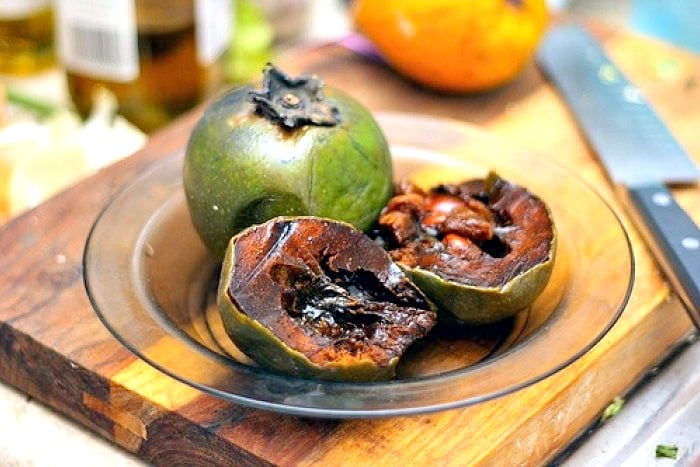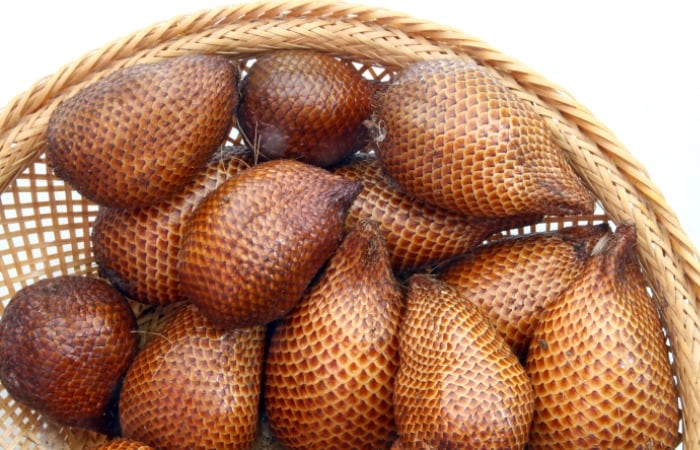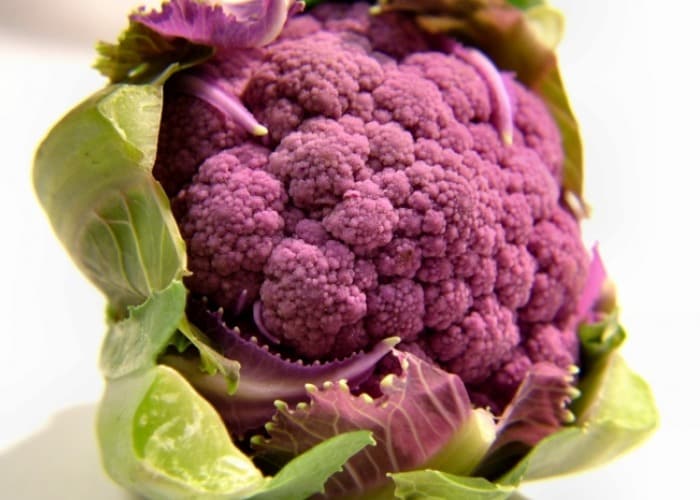Black Sapote - The Fruit That Tastes Like Chocolate Pudding
The black sapote is popularly known as the 'chocolate pudding fruit'. It is a round, green-coloured fruit with brownish interiors. The flesh is rich and custard-like and tastes sweet with a nutty flavour. It is known for its unique chocolate-like flavour and is often used in making mousse, puddings, ice-cream and other desserts.
It grows around eastern Mexico and Central America and is known to contain about four times more Vitamin C than an orange.
Image via Pinterest/Eleanor CandyWatermelon Radish
Also known as 'Roseheart Radish' or 'Red Meat Radish' this variety of radish is relatively new. It is a ball shaped root with whitish exteriors. Cut it open and you're in for a bright pink surprise. The reddish pink flesh resembles that of a watermelon, thus the name.
With a crisp texture it has a mild and sweet flavor. The vibrant taste makes it a great ingredient for salads. It is a heirloom treasure from China.Mangosteen
This fruit is juicy, tangy and sweet. The aromatic inner fleshy cloves surround a seed and enclosed in a hard purple-red shell. It's hard to find the fresh fruit though the canned varieties are found in many western countries. It is a rare delicacy and is used in gourmet desserts. The number of leaves the bottom of the outer shell indicate the number of cloves inside the fruit.Pink Pearl Apple
People in India have eaten the pink guava a lot of times but a pink pearl apple? We don't think so. The pink pearl apple is an apple cultivar developed in Northern California by Albert Etter in 1944. The pale green exterior holds a lovely pink surprise. They are generally medium sized with a conical shape.Purple Potato
This variety of potatoes originated in South America. It looks purple but turns blue when cooked. The purple color is due to the presence of a chemical called anthocyanin which is a great anti-oxidant. They have an earthy and nutty flavor.Pineberry
The pineberry is a white strawberry studded with red seeds. They are the oldest variety of strawberries. It is very fragrant with a pineapple like flavor therefore its named so. It became nearly extinct until in 2003 the Dutch farmers decided to cultivate them.Miracle Berry
A berry that causes sour foods, like lemons and limes, to taste sweet. This flavor change is caused because of miraculin which is used worldwide as a natural sweetener.
So, how does this work?
When the fruit flesh is eaten this molecule binds to the tongue's taste buds, causing sour foods to taste sweet. So if you eat a miracle berry and then eat something sour, it would taste sweet to you! Miracle berry, indeed. The effect lasts for about an hour approximately.
In Japan, this berry is popular among diabetic people.Snake Fruit
This fruit is known so because of its brownish snake-like scaly skin. It is also called salak. The skin can easily be removed and inside are three pulpy segments which are eaten with an inedible seed. Native to Indonesia it has a sweet yet acidic taste.Purple Broccoli
As its name suggest this broccoli has a purple head but what's interesting is that it turns greenish when cooked. It was originally cultivated by the Romans.Prickly Pear
A genus of a cactus family which you can actually eat?
Yes, prickly pear is a type of cactus the fruits of which are eaten. It has to be peeled carefully so as to remove the spines on the outer covering.
It is used in making candies, alcoholic drinks etc.
The color may vary from green, orange to a deep red when the fruit matures. A sweet purple-red juice is extracted from this fruit.
Mexico is the largest producer of prickly pears. It is sweet and juicy.Wild Rice
Wild rice also known as Canadian rice or water oats is considered to be a delicacy in North America.
It is actually a grass and not a rice, the seeds of which are consumed.
It is high in protein, low in fact and gluten free.Duku
Duku is a very popular fruit in tropical Asia. Easily available in Kolkata, India during the summers. Duku can be eaten raw or in preserved form. With a thick outer covering the fruit flesh is sweet and juicy.Horned Melon
This one's also known as the African cucumber or jelly melon. It is native to Africa.
It has a thick and spiky yellow outer covering. The inside jelly like green flesh is eaten which resembles a cucumber with white seeds.
It is known to taste like a banana. Some eat the peel too which is rich in vitamin C and fiber. The seeds are removed and the inside pulp may be cooked or eaten raw.Star Apple
It is also known as the golden leaf tree. Native to Greater Antilles and West Indies, star apple is available in purple and green varities. They have a thick skin which is not edible and the flesh needs to be scooped out.Boysenberry
A boysenberry is a cross between a raspberry and a blackberry therefore its half read, half black. It was first discovered in California. They have a tarty flavor. They are low calorie, cholesterol free fruits.Paw Paw
This fruit is a large edible berry. It's taste is a mix of banana and mango. It is very rich in protein and antioxidants. They have a fragrant aroma and a custard like texture. They taste creamy. They have hard green covering and have the shape of a mango. Inside it has a creamy flesh and a number of black seeds.African Eggplant
Also known as an Ethiopian Eggplant, it is a cross between an eggplant and a tomato. It is actually a fruit that is consumed as a vegetable. It has a bright red color and the shape of an egg, therefore it is also known as the garden egg. It contains 92 percent water and is rich in beta-carotene, vitamin b and c.Salmonberry
Salmonberries look somewhat like a raspberry. It may be eaten raw or used in jams, jellies, to make wine etc. The color varies from orange to red which is somewhat the color of salmon. They are rich in vitamins and antioxidants. The bright orange variety are the best tasting ones.Jabuticaba
The fruit of this tree grows off the trunk! Also known as ?The Brazilian Grape Tree' it is native to South America. The fruit is reddish-purple in color and looks somewhat like a plum. It can be plucked and eaten straight from the trunk.
The fruit is also used to make jellies, wine or liquor. The inner flesh of the fruit is white or rosy pink. It has a very short shelf life as it begins to ferment 3-4 days after the harvest.Chayote
This edible plant belongs to the gourd family. The fruit is pear shaped with a heard wrinkly cover and white flesh inside. It has a bland taste and is cooked before eating. It is rich in amino acids and vitamin c. In South India it is known as 'Chuw Chuw" and used in the preparation of sambar.Dog Dumpling
It is a tree in the coffee family the fruit of which is commonly known as noni or cheese fruit. The fruit is formed from a cluster of flowers and has a pungent odor. It is grassy green, oval in shape with a length of about 10-15 centimeters. The juice of this fruits is very high in potassium. The rough green covering holds a white flesh inside with several black inedible seeds.
Advertisement




















